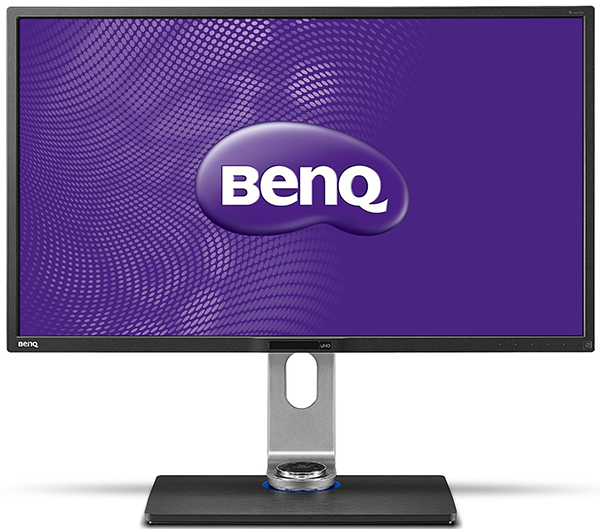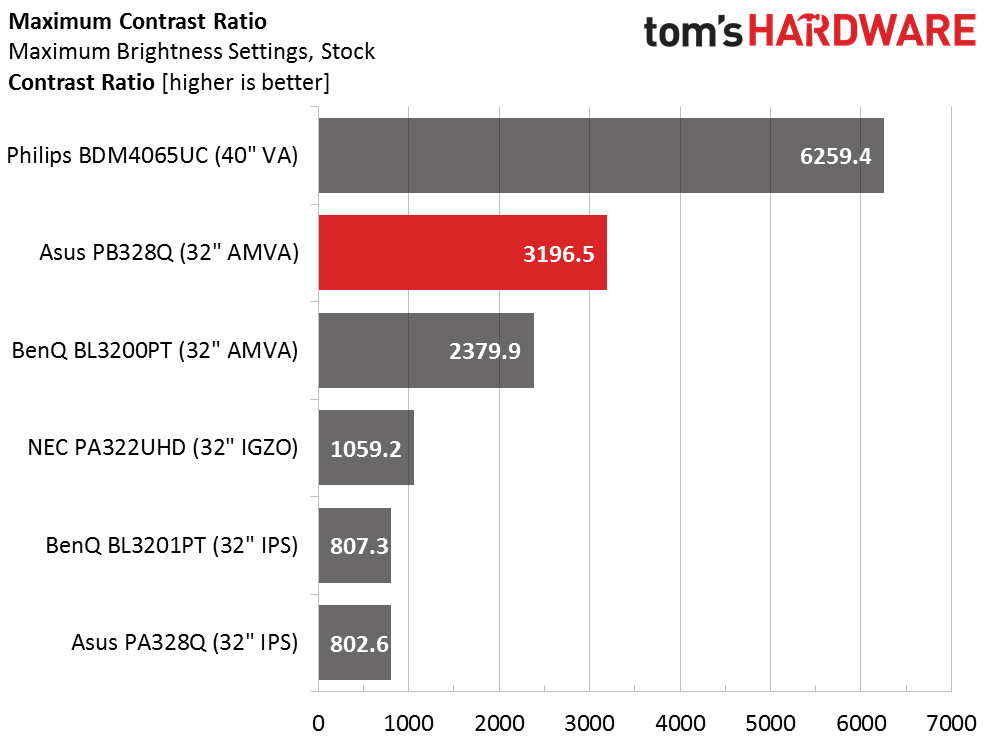Asus PB328Q 32-inch AMVA QHD Monitor Review
Today we're evaluating one of the most accurate and best-performing monitors we've tested: the 32-inch AMVA QHD Asus PB328Q. Let's see how it compares to the tough competition.
Why you can trust Tom's Hardware
Brightness And Contrast
To read about our monitor tests in-depth, please check out Display Testing Explained: How We Test Monitors and TVs. Brightness and Contrast testing is covered on page two.
Uncalibrated – Maximum Backlight Level
Today's comparison group is a battle royale between VA and IPS. On the IPS side we have Asus' PA328Q Ultra HD pro screen; the NEC PA322UHD, also a professional product; and the BenQ BL3201PT, a value-priced UHD display. VA is represented by the Philips BDM4065UC and BenQ's excellent BL3200PT monitor, which uses the same QHD panel part as today's review subject.
Even though BenQ and Asus are using the same panel part, the PB328Q is quite a bit brighter in its maximum output. The manufacturer's claim is 300cd/m2 but that is greatly exceeded here. If you have to use your computer in a brightly-lit room, this 32-inch jumbo screen will still look vivid and saturated.
You can see that VA black levels are not just a little lower than IPS—they're less than half in our tests. The Philips is not likely to be beaten any time soon but the Asus and BenQ screens are running neck and neck.
The difference in contrast between the BenQ and Asus VA panels is due to their maximum output levels. Asus gets more light from the PB328Q. This should demonstrate that plenty of unique developments go into each product irrespective of the parts used. One should not assume identical performance just because base components are the same.
Uncalibrated – Minimum Backlight Level
The PB328Q has a near-ideal minimum brightness of 56.9712cd/m2. Only the Philips and NEC screens go significantly lower. We're glad to see that both BenQ and Asus paid some attention to this detail. There really isn't much reason to set your monitor to only 20cd/m2, it's just too dark for practical use.
The BDM4065UC is in a class by itself when it comes to black levels, but the PB328Q is clearly the best of the rest. Deep blacks like this are not found on typical IPS or TN displays.
Get Tom's Hardware's best news and in-depth reviews, straight to your inbox.
Minimum contrast is just slightly lower than the max value; too slight to be visible in fact. Regardless of the backlight setting, the PB328Q maintains consistent image depth.
After Calibration to 200cd/m2
Thanks to the fine resolution of the white balance sliders, and the fact that they start centered in their ranges, black levels and contrast are unaffected by calibration. You can enjoy the PB328Q without adjustment but there's no penalty for dialing in color and grayscale to perfection.
We've measured plenty of HDTVs that can't match the native contrast of this big Asus. Along with the Philips 40-inch, this monitor is likely to remain at the top of the heap for the foreseeable future. We'll only see a significant improvement in monitor contrast when OLED hits the desktop. This is about as good as an LCD display gets.
ANSI Contrast Ratio
Thanks to superb screen uniformity, the PB328Q posts an ANSI result almost equal to its sequential one. The BL3200PT isn't too far behind so it's clear this is a very high-quality panel part. That it comes at such a low price is just icing on the cake.
Current page: Brightness And Contrast
Prev Page OSD Setup And Calibration Next Page Grayscale Tracking And Gamma Response
Christian Eberle is a Contributing Editor for Tom's Hardware US. He's a veteran reviewer of A/V equipment, specializing in monitors. Christian began his obsession with tech when he built his first PC in 1991, a 286 running DOS 3.0 at a blazing 12MHz. In 2006, he undertook training from the Imaging Science Foundation in video calibration and testing and thus started a passion for precise imaging that persists to this day. He is also a professional musician with a degree from the New England Conservatory as a classical bassoonist which he used to good effect as a performer with the West Point Army Band from 1987 to 2013. He enjoys watching movies and listening to high-end audio in his custom-built home theater and can be seen riding trails near his home on a race-ready ICE VTX recumbent trike. Christian enjoys the endless summer in Florida where he lives with his wife and Chihuahua and plays with orchestras around the state.











